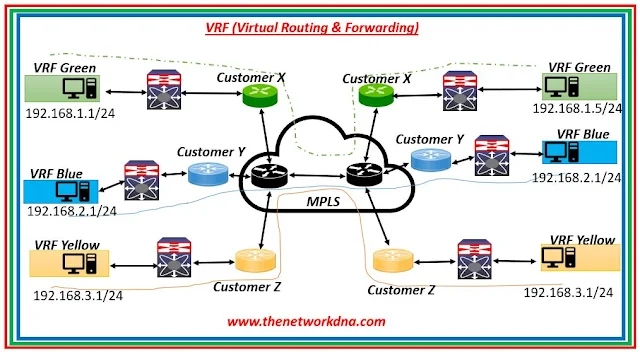Decoding VRF Vs VRF Lite
Decoding VRF Vs VRF Lite
VRF (Virtual Routing Forwarding)
This article is about VRF and VRF lite feature which many of you know and some of you really want to understand the difference between VRF and VRF lite in details.
⭐ VRF (Virtual Routing forwarding)📶
VRF stands for Virtual Routing Forwarding and is a separate routing table within a router. VRFs are to a router what VLANs are to a switch.
Using VRFs, it is possible to virtualize a single router into several instances, each of them being (relatively) independent of each other, allowing for overlapping subnets, separate instances of routing protocols, separate set of interfaces assigned to each VRF.
In other words you can say that VRF stands for virtual routing and forwarding. When you create a vrf, you tell it what routes to import/export. Then you assign that vrf to an interface. Once the vrf is attached to an interface, the switch/router creates a separate routing table to hold those routes.
 |
| Fig 1.1- VRF (Virtual Routing forwarding) |
VRF also increases network security and can eliminate the need for encryption and authentication. Internet service providers (ISPs) often take advantage of VRF to create separate virtual private networks (VPNs) for customers; thus the technology is also referred to as VPN routing and forwarding.
VRF based network design uses 802.1q trunks protocol, GRE tunnels, or MPLS tags to extend and tie the VRFs together.
⭐Related : Introduction to VRF(Virtual Routing forwarding)
⭐ VRF Lite 🔄
A feature in the MPLS environment called VRF-lite allows a service provider to offer several VPNs with the possibility of IP address overlap. By linking one or more Layer 3 interfaces to each VRF, VRF-lite creates virtual packet-forwarding tables by using input interfaces to differentiate routes for various VPNs.
A Layer 3 interface cannot be a part of more than one VRF at once. Interfaces in a VRF can be either logical or physical, such Ethernet ports or VLAN SVIs.
Switches allow multiple VPN routing/forwarding instances in customer edge devices thanks to the VRF-lite capability. Multi-VRF CE, or multi-VRF Customer Edge Device, is another name for VRF-lite. Using a single interface, a service provider may offer many VPNs with overlapping IP addresses thanks to VRF-lite.
⭐Related : Do you know about VRF lite in MPLS networks ?
Here comes the difference and the use case where we use VRF or VRF-lite








